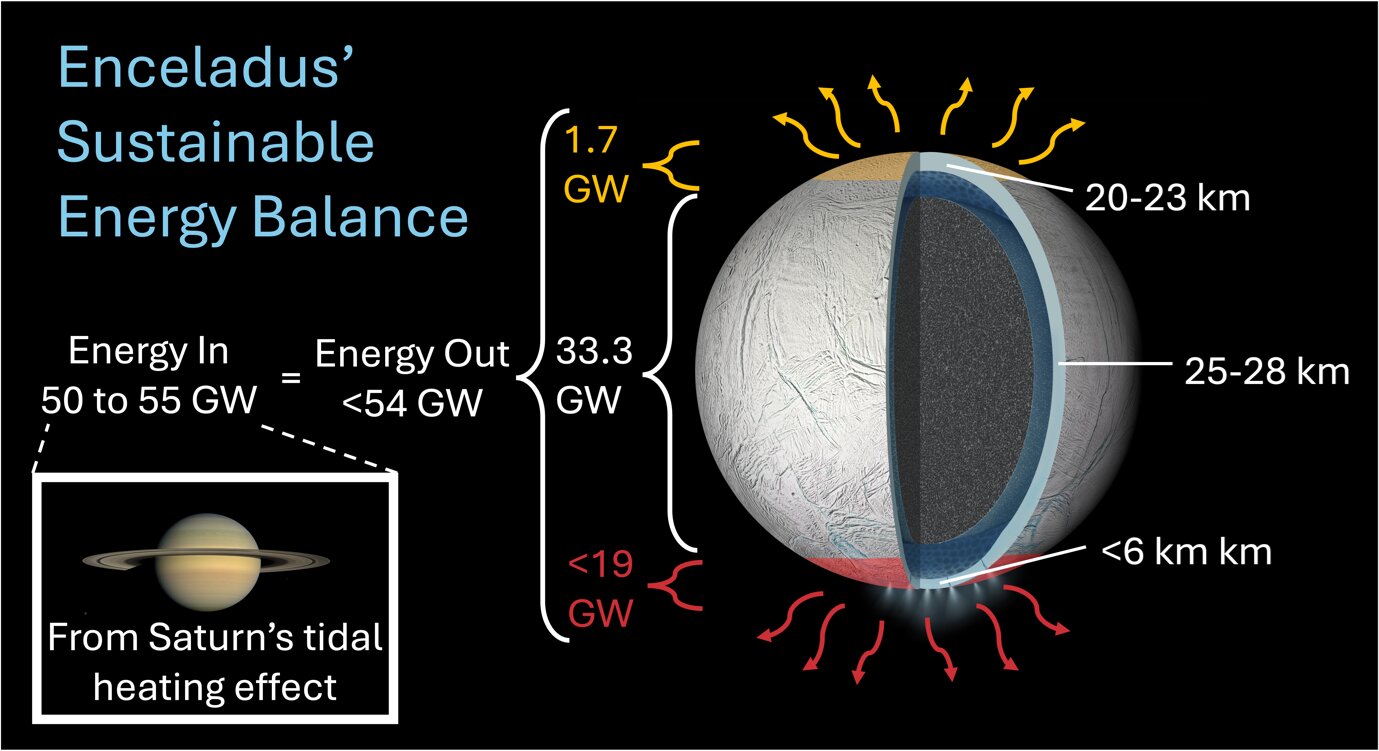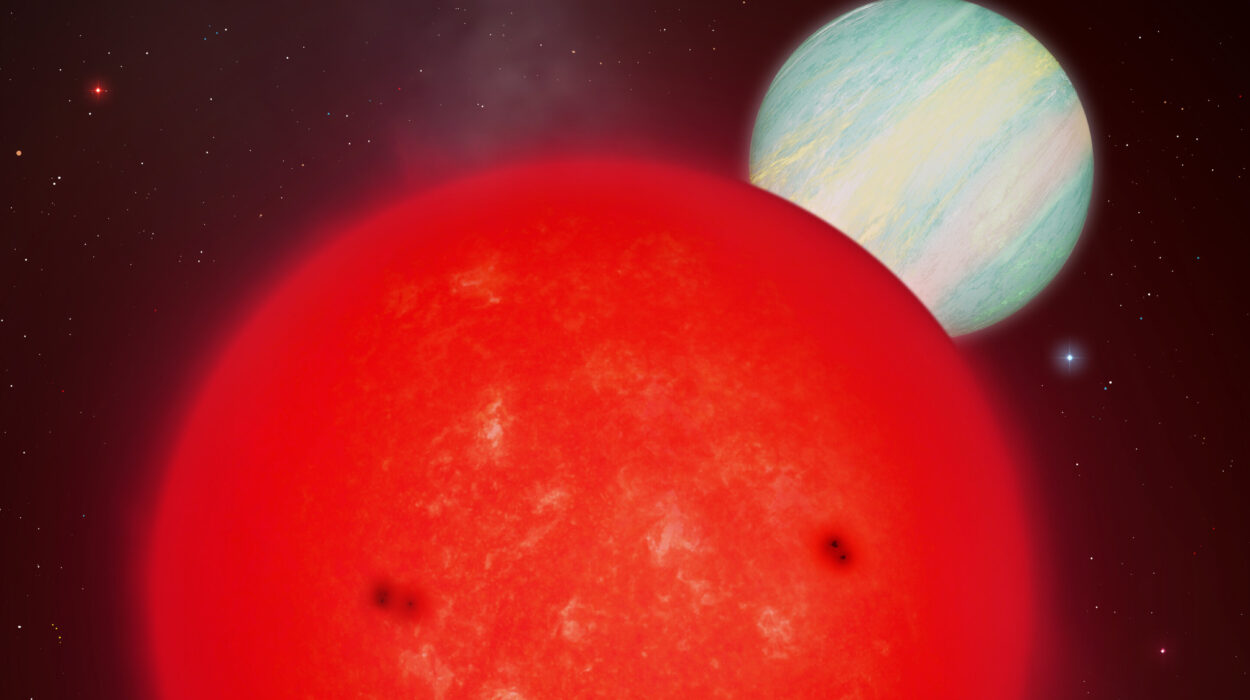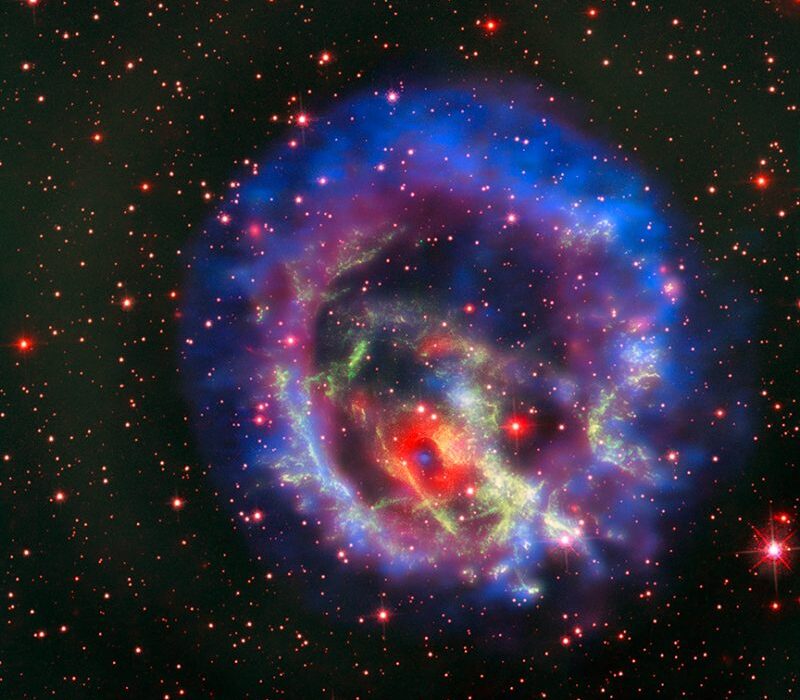Far beyond Earth, orbiting the ringed giant Saturn, lies one of the most fascinating worlds in our solar system—Enceladus. Barely 500 kilometers across, this small icy moon has captured the imagination of scientists and dreamers alike. Beneath its frozen crust, a vast subsurface ocean churns with heat and chemistry, making Enceladus one of the most promising places in our solar system where life might exist.
For years, researchers believed that Enceladus’s heat—and the powerful energy driving its famous plumes of water vapor—was concentrated around its south pole, a region scarred by deep fractures known as the “tiger stripes.” But a groundbreaking new study has revealed a stunning twist: Enceladus’s north pole is also warm, quietly leaking heat from the ocean beneath.
This discovery, led by scientists from the University of Oxford, Southwest Research Institute, and the Planetary Science Institute in Tucson, Arizona, overturns previous assumptions and reshapes our understanding of the moon’s inner life. The findings, published in Science Advances, confirm that Enceladus is far more dynamic—and potentially habitable—than anyone realized.
The Icy Moon with a Fiery Heart
Enceladus is no ordinary moon. Beneath its glittering crust of ice lies a global ocean of salty, liquid water, kept warm by the gravitational pull of Saturn. As Enceladus orbits its planet, the immense tidal forces stretch and squeeze its interior, generating friction and heat. This process, known as tidal heating, prevents the ocean from freezing solid and fuels the moon’s spectacular plumes—towering geysers that erupt from its south pole and shoot water and organic molecules hundreds of kilometers into space.
These plumes were first observed by NASA’s Cassini spacecraft, which orbited Saturn between 2004 and 2017. Cassini’s discoveries transformed Enceladus from a frozen speck into a world of immense astrobiological interest. It found evidence of hydrothermal vents at the bottom of its hidden ocean—places where heat, minerals, and chemistry converge, much like the environments where life first arose on Earth.
Until recently, however, the north pole was thought to be quiet and cold, a frozen desert compared to the activity of the south. But new analysis of Cassini data has revealed that heat is leaking out from Enceladus’s entire globe, suggesting a balanced and sustainable energy system that could support life for billions of years.
A Decade of Data, a Decade of Discovery
To uncover this hidden heat, researchers examined Cassini’s infrared observations of Enceladus’s north pole, taken a decade apart—once during the frigid polar winter in 2005, and again during the bright summer in 2015. By comparing how the surface warmed and cooled, they could measure the amount of heat flowing up from below.
Dr. Georgina Miles, lead author of the study from the Southwest Research Institute and the University of Oxford, explains, “Enceladus is a key target in the search for life outside Earth, and understanding the long-term availability of its energy is crucial. If its heat flow remains stable, its ocean could remain liquid and habitable for eons.”
The results were remarkable. The north polar surface was about 7 Kelvin (–266°C instead of –273°C) warmer than expected. That tiny but measurable difference could only be explained by heat escaping from the ocean below, traveling through 20–30 kilometers of ice before radiating into space.
A World That Glows from Within
While the heat flux might sound small—about 46 milliwatts per square meter—it represents a massive global output. Across Enceladus’s entire surface, that adds up to 35 gigawatts of heat, roughly the combined energy output of more than 10,000 wind turbines or 66 million solar panels.
When combined with the powerful heating already measured at the south pole, Enceladus’s total heat loss reaches about 54 gigawatts, almost exactly matching the tidal energy input predicted by models. This delicate energy balance is vital. It suggests that Enceladus’s interior operates like a stable engine—producing just enough heat to sustain its ocean without overheating or freezing.
Dr. Carly Howett, co-author from Oxford’s Department of Physics and the Planetary Science Institute, said, “It is really exciting that this new result supports Enceladus’s long-term sustainability. The fact that it maintains a stable heat flow means it could keep its ocean liquid for geological timescales—a crucial condition for life to develop.”
In other words, Enceladus isn’t just active—it’s alive with energy, balancing the push and pull of Saturn’s gravity with astonishing precision.
The Ocean Beneath the Ice
The existence of heat at both poles supports the view that Enceladus’s ocean is global, not confined to isolated pockets. Beneath its icy crust lies a salty, mineral-rich sea, possibly as deep as 30 to 40 kilometers, and in direct contact with the moon’s rocky core.
This interaction between rock and water creates a perfect environment for hydrothermal activity, where minerals and heat flow through cracks in the ocean floor. On Earth, similar vents teem with life—microbes that feed not on sunlight, but on the chemical energy released from the rocks themselves.
The new findings make Enceladus even more compelling as a target for astrobiologists. If its ocean has remained liquid and stable for millions or even billions of years, then life could have had the time and opportunity to emerge.
Mapping the Icy Shell
Beyond its implications for habitability, the study also offered new insights into Enceladus’s structure. By modeling the heat flow through the ice, researchers were able to estimate the thickness of the icy crust at different locations.
They found that the ice shell at the north pole is about 20–23 kilometers thick, while the global average is between 25 and 28 kilometers—slightly thicker than previous estimates. This information will be invaluable for future missions that aim to explore Enceladus’s ocean directly, either through ice-penetrating probes or robotic landers capable of melting through the shell.
“Extracting such subtle temperature variations was only possible thanks to Cassini’s extended mission,” Dr. Miles noted. “It shows the incredible value of long-term space exploration. Sometimes the most profound discoveries emerge years after the data is first collected.”
A World of Potential and Mystery
The discovery of global heat flow raises a profound question: How long has Enceladus’s ocean existed? Scientists still don’t know whether it formed relatively recently or has persisted since the moon’s formation billions of years ago. The answer could determine whether life ever had time to evolve beneath its icy crust.
Enceladus’s remarkable balance between energy generation and loss suggests that it could remain active for a very long time. Its ocean, warmed by tidal forces and insulated by ice, could provide a stable refuge in an otherwise hostile solar system.
As researchers continue to sift through Cassini’s treasure trove of data and prepare for new missions, Enceladus stands as a beacon of hope in the search for life beyond Earth—a frozen world that burns with hidden fire.
The Promise of Future Exploration
The next great challenge is to return to Enceladus. Future missions could sample the plumes erupting from its surface, analyze their chemistry for signs of biology, or even send a submersible probe beneath the ice to explore its alien ocean directly.
NASA’s Enceladus Orbilander mission concept and several European proposals envision such explorations within the next few decades. These missions would not only confirm whether life exists beneath the ice but also help scientists understand how habitable environments can arise in unexpected corners of the cosmos.
The Heartbeat of a Frozen World
Enceladus continues to surprise us. What was once thought to be a quiet, frozen moon is now revealed as a living, breathing system—a world with heat, water, and the chemistry of life. Its shimmering plumes, glowing poles, and internal ocean remind us that the universe is not cold and empty, but vibrant and dynamic.
Each new discovery brings us closer to answering one of humanity’s oldest questions: Are we alone? On a tiny moon orbiting Saturn, the answer may be waiting, locked beneath an icy shell, sustained by the steady pulse of a hidden ocean that refuses to freeze.
Enceladus, in its silence and mystery, may yet whisper the first true echo of life beyond Earth.
More information: Georgina Miles et al, Endogenic heat at Enceladus’ north pole, Science Advances (2025). DOI: 10.1126/sciadv.adx4338. www.science.org/doi/10.1126/sciadv.adx4338






